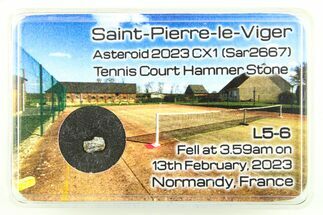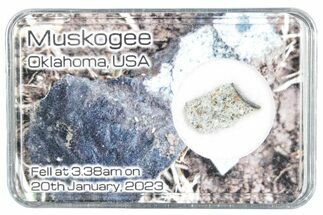.42" Chondrite Meteorite Hammer Stone (0.43 g) - Muskogee
This is a fragment from the unclassified chondrite known as Muskogee, which fell near the town of the same name in Oklahoma very early in the morning on January 20, 2023. This meteorite is a hammer stone, a unique kind of meteorite that hits man-made objects and retains traces of those impacts. It comes in its own labeled display case.
What Is A Hammer Stone?
Hammer stones are the names given to meteorite fragments that hit man-made objects, animals, or people when they fall. Hammer stones are often identified by the scuffed fusion crusts that can contain traces of paint, rubble, or other materials from the objects they hit. Because they are so rare, they are valued collectors' items. Often the items hammer stones hit go up in value, just be being damaged by a meteorite!
Hammer stones are the names given to meteorite fragments that hit man-made objects, animals, or people when they fall. Hammer stones are often identified by the scuffed fusion crusts that can contain traces of paint, rubble, or other materials from the objects they hit. Because they are so rare, they are valued collectors' items. Often the items hammer stones hit go up in value, just be being damaged by a meteorite!
Muskogee fell just after 3:30 AM local time near Muskogee, Oklahoma on January 20th, 2023. The sky was cloudy that night, so a team of meteorite hunters used Doppler radar to triangulate the meteorite's path through the sky and its approximate fall area. When they got to the strewn field, they eventually recovered six stones totaling about 1.4 kilograms, including a hammer stone that struck a barn roof! Pieces have since been donated to various research institutions and the Muskogee Nation, while others such as these are available for private collections. Its classification is still pending.
This is quite the handsome chondrite! It contains chondrules and metal grains with some oxidation within a light gray matrix, and many pieces are fully covered by a beautiful dark fusion crust. It is a truly stunning piece of the solar system.
This is quite the handsome chondrite! It contains chondrules and metal grains with some oxidation within a light gray matrix, and many pieces are fully covered by a beautiful dark fusion crust. It is a truly stunning piece of the solar system.
About Chondrites
Chondrites are stony (non-metallic) meteorites that have not been modified by either melting or differentiation of the parent body. They are formed when various types of dust and small grains in the early Solar System accreted to form primitive asteroids. Some such bodies are captured in the planet’s gravity well and pulled to the surface. They are by far the most common type of meteorite, representing about 86 percent of all meteorites that have fallen to Earth.
Prominent among the components present in chondrites are the enigmatic chondrules, millimeter-sized spherical objects that originated as freely floating, molten or partially molten droplets in space; most chondrules are rich in the silicate minerals olivine and pyroxene. Chondrites also contain particles of various metals such as nickel, iron, and aluminum. These formed at the very beginning of the solar system and aggregated over time: they are the oldest rocks known on Earth!
Chondrites are divided into about fifteen distinct groups on the basis of their mineralogy, bulk chemical composition, and oxygen isotope compositions. The various chondrite groups likely originated on separate asteroids or groups of related asteroids. Each chondrite group has a distinctive mixture of chondrules, refractory inclusions, matrix (dust), characteristic chondrule sizes, and other components. Other ways of classifying chondrites include weathering and shock. The L chondrite group is the most common of these.
Chondrites are stony (non-metallic) meteorites that have not been modified by either melting or differentiation of the parent body. They are formed when various types of dust and small grains in the early Solar System accreted to form primitive asteroids. Some such bodies are captured in the planet’s gravity well and pulled to the surface. They are by far the most common type of meteorite, representing about 86 percent of all meteorites that have fallen to Earth.
Prominent among the components present in chondrites are the enigmatic chondrules, millimeter-sized spherical objects that originated as freely floating, molten or partially molten droplets in space; most chondrules are rich in the silicate minerals olivine and pyroxene. Chondrites also contain particles of various metals such as nickel, iron, and aluminum. These formed at the very beginning of the solar system and aggregated over time: they are the oldest rocks known on Earth!
Chondrites are divided into about fifteen distinct groups on the basis of their mineralogy, bulk chemical composition, and oxygen isotope compositions. The various chondrite groups likely originated on separate asteroids or groups of related asteroids. Each chondrite group has a distinctive mixture of chondrules, refractory inclusions, matrix (dust), characteristic chondrule sizes, and other components. Other ways of classifying chondrites include weathering and shock. The L chondrite group is the most common of these.
$435
TYPE
Ordinary Chondrite (Unclassified)
LOCATION
Muskogee, Oklahoma
SIZE
.42" wide, 0.43 grams
CATEGORY
ITEM
#286106
 Reviews
Reviews









